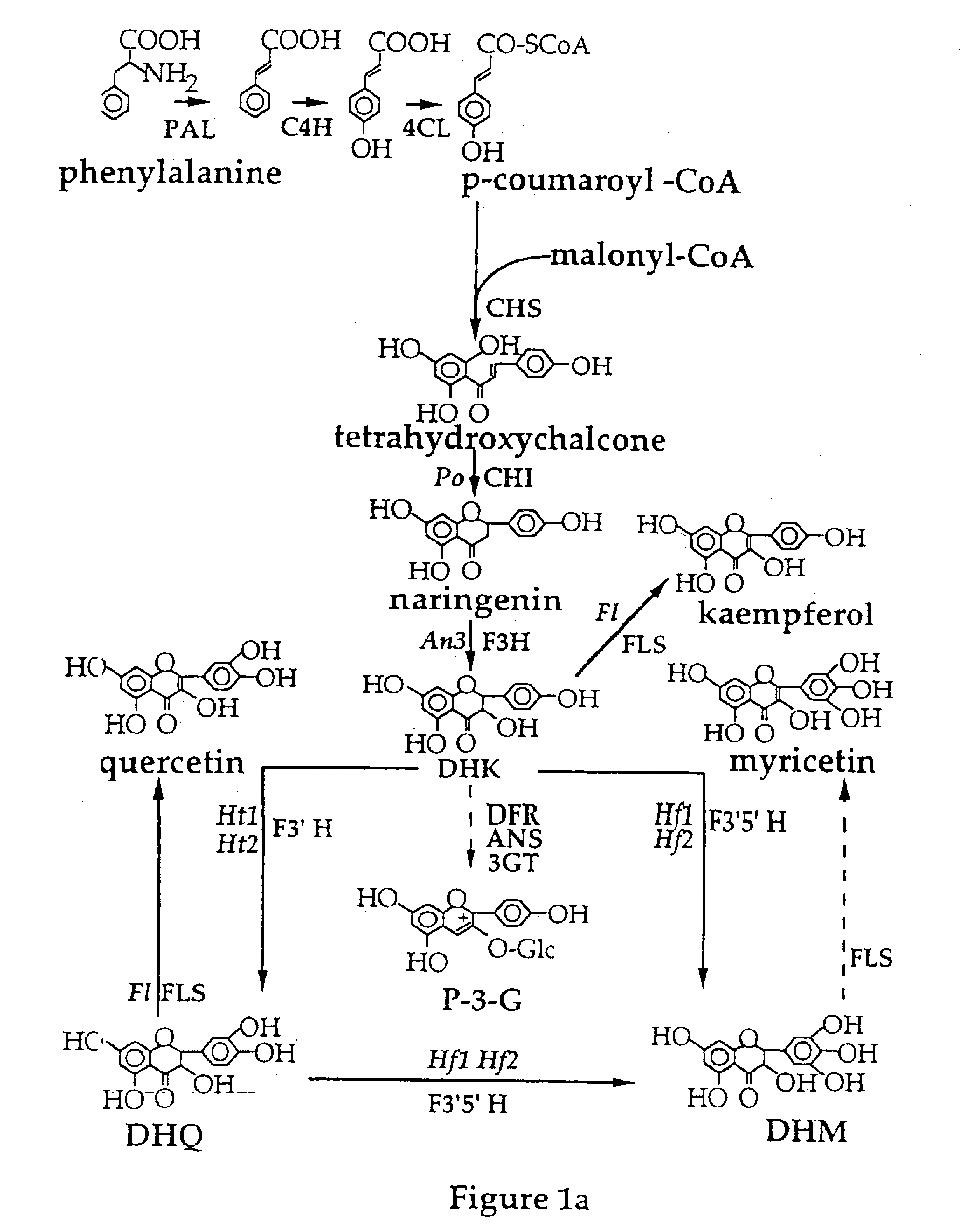Nucleic acid sequences encoding flavonoid 3'-hydroxylase and methods of altering flower color therewith
a technology of flavonoid 3'hydroxylase and nucleic acid sequences, which is applied in the field of nucleic acid sequences encoding flavonoid 3'hydroxylase and methods of altering flower color therewith, can solve the problems of inefficient sequences, and inability to achieve sequences that are inefficient in their ability,
- Summary
- Abstract
- Description
- Claims
- Application Information
AI Technical Summary
Problems solved by technology
Method used
Image
Examples
example 2
Bacterial Strains
The Escherichia coli strains used were:
DH5.alpha. supE44, .DELTA.(lacZYA-ArgF)U169, .o slashed.80lacZ.DELTA.M15, hsdR17 (r.sub.k -, m.sub.k +), recA1, endA1, gyrA96, thi-1, relA1, deoR (Hanahan, 1983 and BRL, 1986).
XL1-Blue MRF' .DELTA.(mcr A)183, .DELTA.(mcrCB-hsdSMR-mrr)173, endA1, supE44, thi-1, recA1, gyrA96, relA1, lac[F' proAB, lacIqZ.DELTA.M15, Tn10(Tet.sup.r)].sup.c (Stratagene)
XL1-Blue supE44, hsdR17 (r.sub.k -, m.sub.k +), recA1, endA1, gyrA96, thi-1, relA1, lac[F' proAB, lacIq, lacZ.DELTA.M15, Tn10(tet.sup.r)]
SOLR e14.sup.- (mcrA), .DELTA.(mcrCB-hsdSMR-mrr)171, sbcC, recB, recJ, umuC::Tn5(kan.sup.r), uyrC,lac, gyrA96, thi-1, relA1, [F'proAB, lacIqZ.DELTA.M15], Su.sup.- (non-suppressing) (Stratagene)
DH10 B(Zip) F.sup.- mcrA, .DELTA.(mrr-hsdRMS-mcrBC), .o slashed.80d lacZ.DELTA.M15, .DELTA.lacX74, deoR, recA1, araD139, .DELTA.(ara, leu)7697, galU, gal.vertline.K.vertline..lambda., rspL, nupG
Y1090r- .DELTA.lacU169, (.DELTA.lon)?, araD139, strA, supF, mcrA, t...
example 3
General Methods
.sup.32 P-Labeling of DNA Probes
DNA fragments (50 to 100 ng) were radioactively labelled with 50 .mu.Ci of [.alpha.-.sup.32 P]-dCTP using an oligolabelling kit (Bresatec). Unincorporated [.alpha.-.sup.32 P]-dCTP was removed by chromatography on a Sephadex G-50 (Fine) column.
DNA sequencing was performed using the PRISM.TM.Ready Reaction Dye Primer Cycle Sequencing Kits from Applied Biosystems. The protocols supplied by the manufacturer were followed. The cycle sequencing reactions were performed using a Perkin Elmer PCR machine (GeneAmp PCR System9600) and run on an automated 373A DNA sequencer (Applied Biosystems).
Homology searches against Genbank, SWISS-PROT and EMBL databases were performed using the FASTA and TFASTA programs (Pearson and Lipman, 1988) or BLAST programs (Altschul et al., 1990). Percentage sequence similarities were obtained using the LFASTA program (Pearson and Lipman, 1988). In all cases ktup values of 6 for nucleotide sequence...
example 4
Isolation of a Flavonoid 3'-hydroxylase (F3'H) cDNA Done Corresponding to the Ht1 Locus from P. hybrida cv. Old Glory Red
In order to isolate a cDNA clone that was linked to the Ht1 locus and that represented the flavonoid 3'-hydroxylase (F3'H) in the petunia flavonoid pathway, a petal cDNA library was prepared from RNA isolated from stages 1 to 3 of Old Glory Red (OGR) petunia flowers. OGR flowers contain cyanidin based pigments and have high levels of flavonoid 3'-hydroxylase activity. The OGR cDNA library was screened with a mixture of .sup.32 P-labelled fragments isolated from three cytochrome P450 cDNA clones known to be involved in the flavonoid pathway and from one cytochrome P450 cDNA clone (651) that had flavonoid 3'-hydroxylase activity in yeast. These included a petunia cDNA clone representing the cinnamtehydroxylase (C4H) and two petunia cDNA clones (coded by the Hf1 and Hf2 loci) representing flavonoid 3'5'-hydroxylase (F3'5'H) (Holton et al., 1993).
Construction of Petun...
PUM
| Property | Measurement | Unit |
|---|---|---|
| temperature | aaaaa | aaaaa |
| angle | aaaaa | aaaaa |
| diameter | aaaaa | aaaaa |
Abstract
Description
Claims
Application Information
 Login to View More
Login to View More - R&D
- Intellectual Property
- Life Sciences
- Materials
- Tech Scout
- Unparalleled Data Quality
- Higher Quality Content
- 60% Fewer Hallucinations
Browse by: Latest US Patents, China's latest patents, Technical Efficacy Thesaurus, Application Domain, Technology Topic, Popular Technical Reports.
© 2025 PatSnap. All rights reserved.Legal|Privacy policy|Modern Slavery Act Transparency Statement|Sitemap|About US| Contact US: help@patsnap.com



